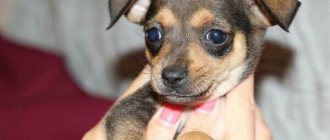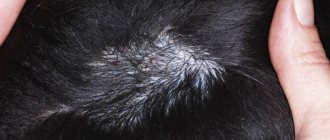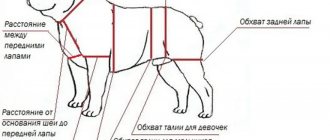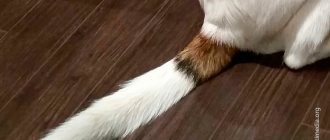Scientific explanation
Docking refers to the surgical removal of part of an animal's tail.
The procedure is carried out solely for aesthetic purposes. With its help, it is possible to create a certain appearance for the animal and maintain breed standards.
Brief historical background
The first mentions of tail cutting can be traced back to Ancient Rome. Then the shepherds were convinced that if the last of the tail vertebrae was docked in puppies, the dog would be protected from rabies for life.
Such manipulations were carried out strictly on the fortieth day from the moment the babies were born.
After a while, they began to resort to this procedure for other reasons. It was performed on guard and hunting dogs to prevent injury. The tail was considered only an appendage. They could have stepped on him and grabbed him. In this way they tried to protect the pet from damage from thorns and foxtail.
A more banal reason was not about caring for dogs, but about money: in the 18th century, a tax was introduced on all dogs in England. The only exceptions were service breeds, for which it was customary to have their tails docked.
Dog breeders who performed this procedure on their animals were exempt from this tax.
The tax law was soon repealed, but tail docking was still practiced for a long time: the procedure was carried out only for the purpose of winning at the exhibition. Only at the end of the 19th century in Great Britain they began to allow dogs to participate in the form in which nature created them.
Prohibition on the procedure
In the 90s of the 20th century, the European organization of dog handlers decided to abandon this operation. She was considered inhumane and useless.
Now it is banned in many countries. Among them:
SOUTH AFRICA;- Australia;
- Iceland;
- Switzerland;
- Norway;
- Israel.
In the UK, docking is also prohibited. But in special situations the procedure is acceptable.
When is the procedure allowed?
Docking is carried out if the dog is in service or performs the following functions:
- in the armed forces;
- in law enforcement agencies;
- destroys rodents;
- in the emergency rescue service.
The Science of Tail Docking
Tail docking is a procedure that removes part of a puppy's tail in the first days of its life, and is prohibited or restricted in many countries in Europe and Australia. But in the USA, Canada and some other countries, tail docking for the sake of beauty (the owner’s desire, fashion) is still allowed.
History of tail docking in dogs
The history of tail cutting can be traced back to Ancient Rome. Lucius Columella, who wrote works on agriculture in the 1st century. AD, states in his Res Rustica that the shepherds believed that if the last tail vertebra of puppies was cut off on the fortieth day, the tail would not grow and the dog would not get rabies.
Later, tails were docked for a variety of other reasons. The tails of hunting and guard dogs were cut off in the hope of preventing injury to them, explaining that the tail was just another appendage that the dog could be grabbed or stepped on. In addition, as some sources indicate, the tails of dogs that worked in the underbrush were docked to prevent damage from thorns and foxtail (grasses that often cause unpleasant injuries to dogs).
But there is another historical reason that has nothing to do with animal health concerns: money. In the 18th century, a tax was introduced in England on dogs, except for service dogs. Service dogs had their tails docked, and so cutting off tails became a common way to avoid tax liability. It was also a way to “prove” that your dog was not a hunting dog (and that you were not a poacher), since long-tailed dogs were considered most suitable for hunting in those days.
D.D. Wood, in his Illustrated Natural History (1853), offers some hint as to how the practice of cupping became widespread:
The Sheepdog's tail, long and bushy, is usually removed at an early age due to now outdated laws that refuse to recognize a dog as a Shepherd and exempt its owner from paying tax unless it has its tail removed. This law, however, often creates its own object for many people who love coursing (greyhound racing) and care little about appearance, cutting off the tails of greyhounds and, evading the tax, describing them as sheep dogs.
In 1796, the law was repealed, but the practice of tail docking continued - often for purely aesthetic rather than practical reasons. In the 19th century, books such as the American Book of the Dog (1891) show us that the docked tail became associated not with the safety of the dog, but with a certain appearance of the breed. Ear and tail trimming was deemed necessary just to win the show. (In Great Britain, the Kennel Club allowed dogs with cropped ears to participate in exhibitions only in 1898).
Tail docking is currently illegal in Australia and most of Europe, but legal in the US and most of Canada. In England and Wales, tail docking has been banned under the Animal Welfare Act 2006, but exceptions are made for dogs that are involved in work such as law enforcement, armed forces, emergency response, pest control (rat) and hunting. . In accordance with the Animal Welfare Act, the docking procedure must only be performed by a veterinarian within the first 5 days after the animal is born. The Kennel Club allows dogs with docked tails to participate in shows if they have a legal reason to do so. The American Kennel Club allows dogs with cropped ears and tails and dewclaws removed to participate in shows if required by the breed standard.
How is tail docking done?
There are two ways dogs have their tail docked. The first involves using surgical scissors to cut off part of the tail during the first few days of life (Some veterinarians recommend this procedure be done 2-5 days after birth, but sometimes tails are docked much later). The procedure is performed without anesthesia and usually does not require stitches. (You can watch videos of tail docking on Youtube if you're interested, but be warned, it's not for everyone). In countries where tail docking is restricted, the procedure is performed by veterinarians, but in the United States and Canada, where tail docking is legal, it is often performed at home by the puppy's breeder or owner.
The second method involves placing a ligature (elastic band) on the puppy's tail, which stops the flow of blood to the tip of the tail. After a few days, the end of the tail falls off and the ligature is removed.
But not all short-haired dogs have gone through this procedure. Natural bobtail occurs in several dozen dog breeds, including English Bulldogs, Australian Shepherds, Boston Terriers, Pembroke Welsh Corgis, and others (bobtail has also been introduced into some Boxer lines by crossing them with Corgis). In most of these breeds, the C189G gene mutation is associated with the presence of a short tail. The mechanism of natural bobtail in other breeds is still unknown. This does not mean, however, that all representatives of these breeds have a naturally short tail; only those with these genes are born bobtailed.
Doesn't tail docking protect against injury?
Preventing tail injuries has long been a popular informal rationale for tail docking for working dogs, but does it really help? There have been several studies that have attempted to answer this question.
Proponents of tail docking typically point to a Swedish study that looked at 50 litters of German Shorthaired Pointers born in 1989, after tail docking was banned, and three litters of docked tail puppies born in 1988. The study found that 38% of dogs with undocked tails were injured during the first 18 months of life, and that by 1991 this had risen to 51%. By the time the study was published in 1992, seven dogs had had their tails amputated.
More recent studies have also examined the prevalence of tail injuries in hunting dogs. A 2008 study of injuries and lameness in pointing dogs in the UK found "a significant association between tail injuries and undocked tails in springers and cocker spaniels." A 2014 study on hunting dogs and terriers in Scotland found that of 2,860 working dogs, 13.5% suffered tail injuries during the 2010-2011 hunting season. Some breeds, however, were more prone to tail injuries than others, with 56.6% of spaniels and 38.5% of retrievers suffering injuries. Although this topic requires further study, it is possible that tail docking may possibly protect some breeds working in certain situations.
However, for non-hunting dogs who like to lay on a rug, tail docking does not seem to have any benefits. A 2010 study of 138,212 dogs in the UK found that only 0.23% of dogs were at some risk of tail injury, meaning that only 500 of these dogs could be recommended to have their tail docked to prevent injury. Interestingly, this study found no significant difference in tail injuries between working and non-working dogs.
In the essay “The Tale of the Tail: Is Mutilating Animals Justifying Their Interests or Ours?” In Dilemmas in Animal Welfare 2014, Sandra Edwards and Rawleen Bennett noted that breeding bob-tailed dogs is not a good alternative for docking. Pedigree dogs are already faced with the problem of a small gene pool, and reducing it further in order to breed only those dogs that carry bobtail genes can lead to even greater health problems in these breeds.
What effect does tail docking have on a dog?
A serious question regarding tail docking is: Do puppies feel discomfort and pain during the docking procedure? One of the key arguments in favor of tail docking without anesthesia is that puppies are too immature to feel pain. If you watch a video of tail docking with scissors, you will probably notice that the tails squeak louder than usual. In 1996, a study was conducted on 50 puppies at the veterinary clinic at the University of Queensland. The scientists noted that each of the puppies squealed during the procedure and whined immediately after it. On average, puppies stopped vocalizing 138 seconds after stopping, with a maximum time of 15 minutes before calming. The authors note that this means that puppies feel acute pain, but it is difficult to quantify.
There is also the question of whether this pain may have long-term consequences. A recent study in rats traced the effects of nerve injury in newborns on pain sensitivity later in life, but this area of biology remains poorly understood.
In addition to being painful, cupping is a traumatic procedure that is associated with certain risks. Complications may occur immediately after surgery, such as infection (although there are no definitive statistics on this), or it may be associated in some dogs with neuroma (a potentially painful regrowth of nerve tissue in the tail stump). Neuromas can cause discomfort that encourages dogs to continually lick and injure the tail stump, which can lead to a risk of infection and may require surgical treatment.
Further research is needed to understand the real benefits of tail docking in some hunting dog breeds, but for the majority of our pets there are no health or comfort benefits and it is nothing more than a purely aesthetic procedure.
Life without a tail
There are different opinions on this issue. In particular, veterinarian Robert Wansborough, whose 1996 article was published in the Australian Veterinary Journal, criticizes tail docking from an anatomical point of view. Wansborow states that the tail is vital as a balance for a dog, and that the loss of a tail can impair dogs' motor skills and contribute to the development of urinary incontinence. The American Veterinary Medical Association notes that while there is some early evidence suggesting a link between tail docking and urinary incontinence, “there is no convincing evidence that dogs with naturally bob-tailed or surgically removed tails have any limitations compared to dogs with normal tail."
Another area that is currently being widely studied is the role of the tail in dog communication. While smell and sound play an important role in dog communication, there is growing evidence that dogs, like humans, rely heavily on visual information to communicate. In a study published in 2008 in the journal Behavior, researchers used two robot dogs with a long tail and a short tail to observe how dogs in a park interacted with them. The researchers found that dogs were more likely to approach the long-tailed robot when it was wagging its tail (91.4%) than when it was not moving (74.4% of the time). At the same time, dogs were almost as likely to approach a robot with a short tail when it was wagging it (85.2%) as when it was not wagging it (82.2%). The study shows that dogs seem to have an easier time reading the signals of dogs with long tails than those with short tails. Also, a recent study showed that dogs react differently to asymmetrical tail wagging.
Even if we are just beginning to understand the importance of the tail in canine communication, the American Veterinary Medical Association sees no reason to remove the tail for purely cosmetic purposes. In its statement against tail docking when it "satisfies only the owner's desire for an aesthetic appearance," he points out that
Tail removal in young puppies to prevent risk should be based on compelling evidence that the animal is at high risk for tail injury due to a congenital defect, breed predisposition, or intended use. And such reasons must be supported by evidence, for example, empirical data or impartial expert opinion based on extensive experience in the field.
Links:
- Tail Injuries of Shorthaired German Pointer Dogs Born in Sweden in 1989
- A survey of gundog lameness and injuries in Great Britain in the shooting seasons 2005/2006 and 2006/2007
- Survey of tail sustained injuries by working gundogs and terriers in Scotland
- Risk factors for tail injuries in dogs in Great Britain
- Behavioral observations of puppies undergoing tail docking
- The emergence of adolescent onset pain hypersensitivity following neonatal nerve injury
- Association in bitches between breed, size, neutering and docking, and acquired urinary incontinence due to incompetence of the urethral sphincter mechanism
- Behavioral responses of Canis familiaris to different tail lengths of a remotely-controlled life-size dog replica
- Seeing left- or right-asymmetric tail wagging produces different emotional responses in dogs
Original: Stop Cutting Off Your Pet Dogs' Tails, America
See also:
- Possibilities and limitations of genetic testing in dogs
- Is this dog really happy?
- Key Canine Genetic Innovation: Diet
- How to evaluate a dog's intelligence?
- Do dog breeds differ in pain sensitivity?
- When the nose doesn't know: how health, living conditions, training and microbiota affect a dog's sense of smell
- Dogs shouldn't be afraid of fireworks
- How does your dog's nose know so much?
- Quality of life for dogs
- To cut or not to cut: what do we know about the properties of fur and thermoregulation in dogs
- 13
Shared - 10
- 2
- 1
Rules
The procedure should only be performed by an experienced veterinarian. It is strictly prohibited to independently resort to such actions at home, otherwise irreparable harm may be caused to the animal.
Depending on the breed characteristics of the puppies, docking is carried out 2-7 days from the moment of their birth. During this period, the vertebrae do not have time to get stronger; they are quite soft.
An adult dog's tail cannot be trimmed. Speaking about the age at which surgery is permissible, it is worth noting that it is not performed after 4 weeks.
Cupping site: how to determine
The place of docking directly depends on the breed of the pet.
The operation is performed strictly on a specific vertebra. True, it is very problematic to palpate and determine the right place in recently born babies. Where to make the cut is determined by a special technique that differs for all breeds.
Only an experienced specialist who understands the anatomy of the animal can choose the correct length. The veterinarian knows what the exterior of representatives of a particular breed should be like, and he will perform all actions in accordance with the standards.
Why do dogs have their tail docked - the history of the procedure
Many people do not understand why the tails of some dog breeds are cut off. But this tradition appeared a very long time ago. In ancient Rome, part of the tail was removed from dogs that herded livestock. It was believed that this would protect them from rabies. Hunting dogs had their tails cut off to prevent them from getting hurt in the forest while chasing the beast. Often the tails of shepherd dogs were cut, as they guarded livestock and faced attacks from wolves. If the tail was damaged in a fight, recovery was very painful and difficult.
Dog docking is a complex procedure that causes a lot of controversy.
In the 18th century in England there was a tax on dogs. To avoid it, the owners cut off the tails of their pets, since the owners of service dogs did not pay the tax, and a docked tail indicated that they belonged to a similar breed. This way the owners saved money.
Important! In most European countries today such operations are completely prohibited. They can only be carried out in case of medical indications. The only exceptions may be rescue or service dogs.
Trimming the tails and ears of animals began in ancient Rome.
Tail docking length
The length of the tail directly depends on the breed of the dog. Dobermans, Rottweilers and boxers are left with two vertebrae, while poodles, cocker spaniels, and Airedales are left with half a tail.
Cupping methods
There are two methods for carrying out such an operation. Surgical scissors or a tight rubber band can be used. The technology for performing the procedure differs significantly depending on the chosen option.
Using surgical scissors
Conducted by two people. One of them needs to hold the puppy, and the other needs to circumcise. Procedure:
The tail is tightly clamped in the right place with the index finger and thumb.- Circumcision is performed with scissors.
- The cut area remains clamped for 2 minutes.
- The damaged area is treated with a powdered antiseptic.
If the tail is cut too short, the situation cannot be corrected. There is a risk of bleeding, and the resulting wound may become infected.
Often they decide to stitch the wound. If docking itself causes slight pain to the puppy, then suturing is very painful.
After the operation, you need to carefully monitor the puppy for several hours. Due to this, it will be possible to detect and stop bleeding. Healing of the stump occurs quickly. The resulting crust disappears after 20-30 days.
Application of a ligature
During the procedure, the skin is pulled as far as possible to the root of the tail, then wrapped around the vertebra and tied tightly with an elastic band.
The procedure can also be performed this way:
- Roll the elastic several times.
- Place it on the cap of a ballpoint pen.
- Insert the baby's tail into the cap.
- Move the elastic band to the desired area.
If you were unable to select the correct location for the elastic the first time, you can simply cut it off and then perform this action again. In this case, the risk of bleeding is reduced to zero. Accordingly, sepsis does not occur.
The blood supply in this area is simply blocked, and after a few days the tip dies and falls off.
Boxer ear cropping surgery
In itself, such an operation, if you have a special tool, is not very difficult. But it often happens that a dog’s ears have different thickness and density, and there are differences in set and turn. Therefore, it is important to find an experienced veterinarian so that he can correct the truly beautiful shape of the ears. In boxers, according to the standard, the cropped ear should have a sharp shape, and it should not be too short or wide. Don't worry, the operation is painless and takes place under anesthesia, so there won't be much stress for the puppy.
Having decided to dock, you should know that for several months the dog’s ears will have to be constantly treated, treated and glued, forming the correct position of the auricle. Prepare any medicines and medications you may need in advance. Buy solcoseryl jelly, brilliant green, hydrogen peroxide, antibacterial powder, and an alcohol solution of chloramphenicol at the pharmacy. You will also need analgin, diphenhydramine, voloserdin and dressings: sterile wipes, cotton-based adhesive plaster. Purchase a post-surgery collar for your dog that protects his ears.
Immediately after the operation and for several days afterwards, give the dog a few drops of voloserdin and diphenhydramine with analgin to calm it down and relieve pain. The more she sleeps these days, the better. The sutures will need to be removed on the 10th day, and the dog must wear a post-op collar during this time. Regular treatment of sutures is a guarantee that they will heal quickly and there will be no adhesions.
Life without a tail: does surgery affect the dog?
Before deciding to undergo this procedure, it is worth assessing all the risks. You should think about how your pet will feel after the operation, what complications may arise, and whether the absence of a tail could affect its future life.
Painful sensations
The pain syndrome does not disappear, even if anesthesia was used during the operation.
The puppies will cry and squeak for a long time. Dog breeders often note that babies lose their voice during the postoperative period. This happens if the pet damages the ligaments from screaming.
Risk of complications
In the postoperative period, a purulent process may begin . Such problems are often observed when using unsterile devices, or when a person does not treat the damaged areas with an antiseptic.
Similar changes can be observed if a mother begins to actively lick her babies’ wounds.
If healing occurs slowly, scars and scars appear on the affected area. The appearance of the tail becomes less attractive.
Scientists have identified a number of negative changes that can occur as a result of cupping:
weakening of motor skills;- improper distribution of the load on the hind legs, pelvic region, as a result of which the limbs are deformed and the muscles atrophy;
- increased risk of intervertebral hernia formation;
- development of pathologies of the urinary system;
- aggression.
It has been scientifically proven that animals with docked tails have a significantly reduced overall sensitivity.
Discomfort
The tail is a kind of rudder that allows you to properly distribute the load on bones and muscle tissue. In its absence, it is much more difficult for the animal to cope with the task.
The dog experiences obvious discomfort, and the risk of problems with the musculoskeletal system increases.
Communication with others like you
Dogs without tails have obvious problems communicating with their fellow dogs.
It is noted that their fellow tribesmen react to them differently than to animals left in their original form. Scientists conducted an experiment. It involved robots in the form of dogs. Experience has proven that animals approached the bobtail robot much less frequently and showed aggression.
Thus, it was concluded that the tail is an important means of communication. In its absence, communication between dogs becomes significantly more difficult.
Scientists' opinions on the procedure
Scientists have not yet come to a consensus on cutting the tail of dogs.
Many veterinarians criticize this procedure, considering this part of the body to be vital from an anatomical point of view. As a result of its removal, motor skills are impaired and urinary incontinence develops.
Among scientists there are those who are not so categorical. They believe that tail removal is acceptable to prevent injury.
Expert opinion
Makarenko Svetlana Igorevna
Practicing veterinarian, 15 years of experience.
True, in this case it is necessary to provide convincing evidence and justify the risks, for example, breed predisposition, birth defects or the further use of the animal.











